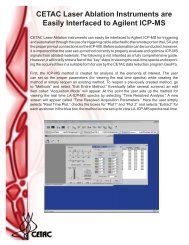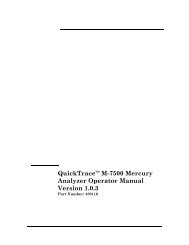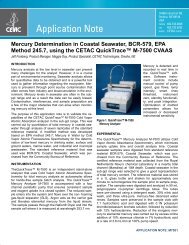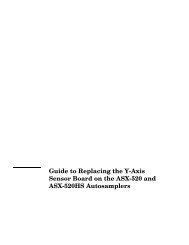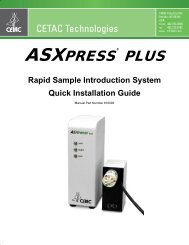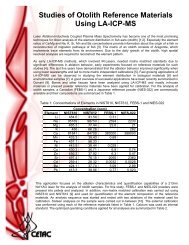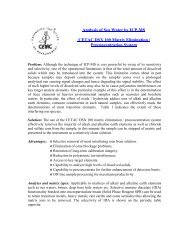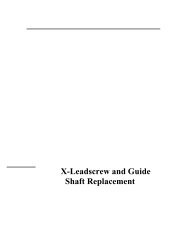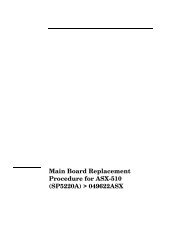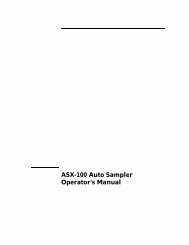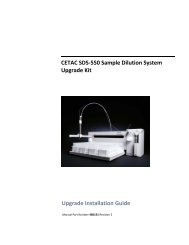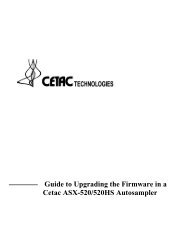CETAC M-7600 Mercury Analyzer Operator's Manual
CETAC M-7600 Mercury Analyzer Operator's Manual
CETAC M-7600 Mercury Analyzer Operator's Manual
Create successful ePaper yourself
Turn your PDF publications into a flip-book with our unique Google optimized e-Paper software.
<strong>CETAC</strong> QuickTrace M-<strong>7600</strong> <strong>Mercury</strong> <strong>Analyzer</strong><br />
Chapter 3: Installing the <strong>Analyzer</strong><br />
15 The flow into the GLS should be as smooth and pulse free as possible.<br />
View this closely at the top of the GLS frosted center post. The liquid should<br />
stream continuously from the capillary tip to the top of the post, and the liquid<br />
column spanning the gap between the capillary tip and post should be nearly<br />
“motionless,” with minimal fluctuation and no jerkiness or discontinuity. If this<br />
is not the case check that the “gap” between the bottom of the GLS capillary<br />
insert tube and the top of the GLS frosted center post is ~0.5 mm (range of 0.3-<br />
0.6 mm). If not, very carefully slide this insert up or down, as needed. Refine<br />
the clamp tension of the sample and reagent channels as needed to stabilize<br />
the liquid flow to the GLS.<br />
A flow check with a 10 mL graduated cylinder (less than 100 mm tall) and<br />
stopwatch should yield a sample uptake rate of ~15 mL/min, and a reagent<br />
uptake rate of ~5.7 mL/min. Check liquid flow stability at the drain exit of the<br />
GLS after final adjustments of clamp tension to sample and reagent pump<br />
tubing. The pump tension will not need further adjustments; do not adjust<br />
pump tension to compensate for worn pump tubing.<br />
NOTE:<br />
When properly adjusted the tension on the bottom three peristaltic pump<br />
tubes (channels 1-3) should be the same and the tension screw for the top<br />
pump tube (reagent tube, channel 1) should be screwed in 1 to 2 mm farther<br />
than the other channels.<br />
Step 15: Check the Reagent Flow<br />
1 Fill the 10 mL graduated cylinder with 10 mL DI water.<br />
2 Simultaneously place the reagent uptake tube in the graduated cylinder and<br />
start the stopwatch.<br />
3 After 30 seconds, remove the uptake tube from the cylinder.<br />
4 Measure the water remaining in the cylinder, and calculate the reagent flow<br />
rate.<br />
Step 16: Check the Sample Probe Flow<br />
1 Fill the 10 mL graduated cylinder with 10 mL DI water.<br />
2 Move the sample probe to the middle of the sample rack. (1:35 if set for a 60<br />
position rack).<br />
3 Position the graduated cylinder beneath the sample probe.<br />
4 Simultaneously click the Down button and start the stopwatch.<br />
73



